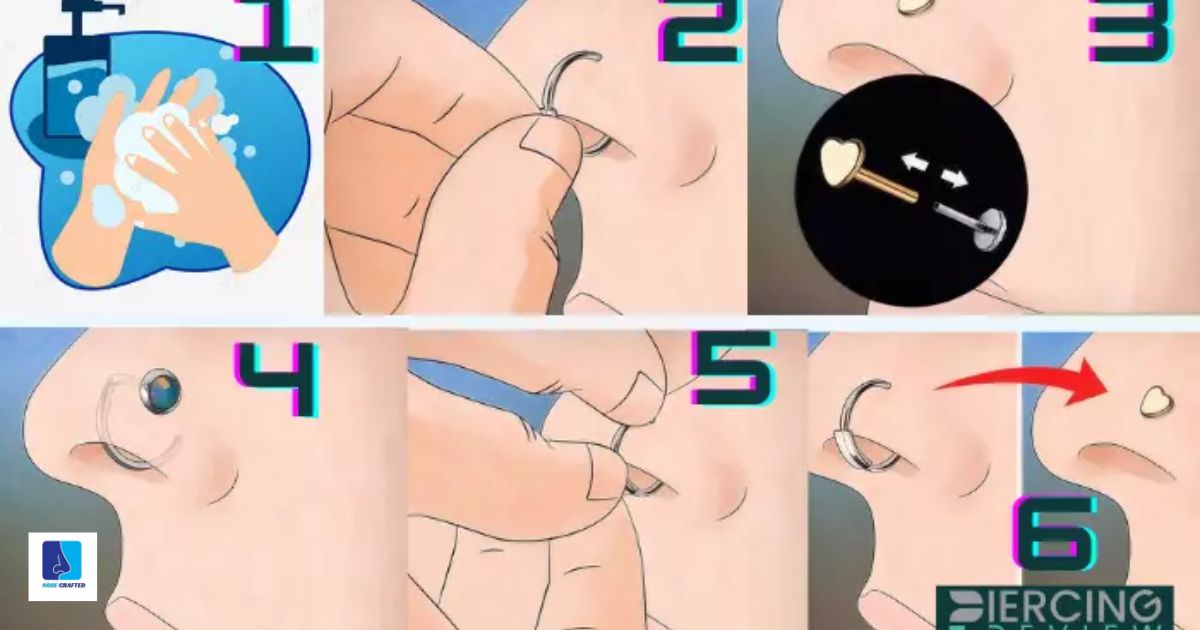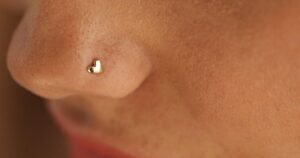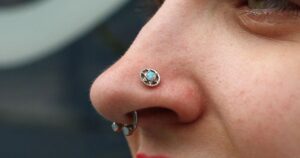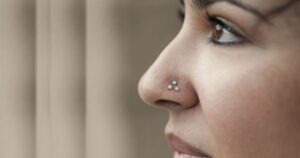Nose piercing is a form of body modification where a small hole is made in the skin or cartilage of the nose, typically for the insertion of jewelry. It’s a cultural and aesthetic practice found in various societies globally. The process involves sterilization and piercing by a professional to minimize risks of infection. Nose piercings have been historically significant in many cultures and are a popular fashion statement today.
Discover how to effortlessly fix an embedded nose piercing in just 6 simple steps. Don’t let discomfort linger take action now to ensure your nose piercing heals properly and painlessly. Follow our easy guide and reclaim comfort and confidence with your piercing today.
Fixing an embedded nose piercing involves carefully addressing discomfort or irritation caused by jewelry sinking into the skin. In six simple steps, you can alleviate pain and ensure proper healing. This process typically includes cleansing the area, gently adjusting the jewelry, and monitoring for improvement. Following these steps can help restore comfort and preserve your piercing’s health.
What Is An Embedded Piercing
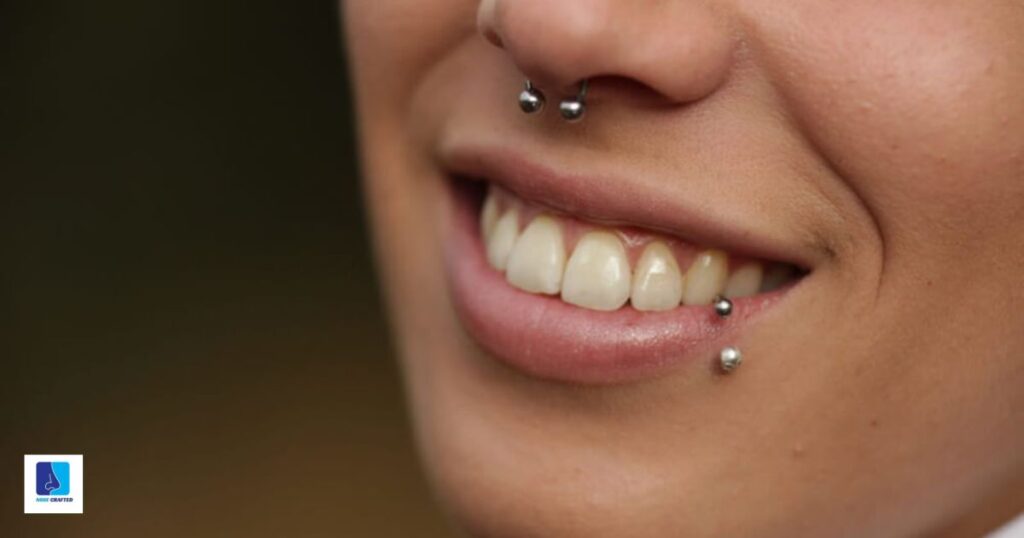
An embedded piercing occurs when the jewelry, such as a stud or ring, becomes partially or fully trapped within the skin surrounding the piercing site. This can happen due to various factors, including swelling, improper jewelry size, or trauma to the area. When the jewelry embeds itself into the skin, it can cause discomfort, redness, and even infection if left untreated.
To address an embedded piercing, it’s crucial to take prompt action. This may involve gentle manipulation to free the jewelry, cleaning the area thoroughly to prevent infection, and seeking professional assistance if necessary. Early detection and proper care can help resolve embedded piercings and prevent further complications.
Nose Piercing Embedded In Skin
When a nose piercing becomes embedded in the skin, it can lead to discomfort and potential complications. This occurs when the jewelry, such as a stud or ring, starts to sink into the surrounding skin due to swelling, improper placement, or inadequate care. If left unaddressed, an embedded nose piercing may cause pain, inflammation, and even infection.
To resolve this issue, it’s crucial to act promptly. First, gently clean the area with saline solution to reduce the risk of infection. Then, carefully attempt to adjust the jewelry to relieve pressure on the skin. If the piercing remains embedded or causes significant discomfort, seek professional assistance from a piercer or healthcare provider to ensure proper care and prevent further complications.
Embedded Nose Piercing Removal
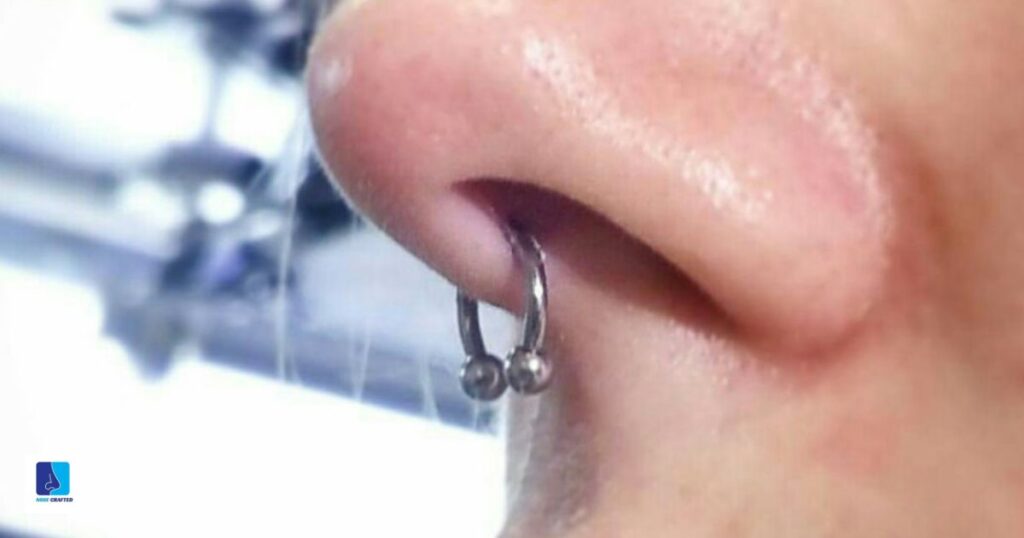
Embedded nose piercing removal is a crucial process for individuals experiencing discomfort or complications with their nose jewelry. When a piercing becomes embedded, it means the jewelry has sunk into the surrounding skin, potentially causing pain, irritation, and infection. Prompt removal is essential to prevent further complications and promote healing. It’s important to note that certain cultural or religious beliefs may also influence decisions related to body piercings, and some individuals may have concerns about nose piercing in the context of their faith, such as whether it is considered permissible or prohibited. Understanding and respecting diverse perspectives on topics like nose piercing haram can contribute to informed and considerate discussions in the broader context of body modification.
To safely remove an embedded nose piercing, it’s important to first cleanse the area with a gentle saline solution to reduce the risk of infection. Next, carefully assess the piercing site and surrounding skin to determine the extent of embedding. Using clean hands and sanitized tools, gently loosen the jewelry from the skin, taking care not to cause additional trauma.
After successfully removing the embedded jewelry, it’s advisable to clean the area again and apply a mild antiseptic to prevent infection. Keep the area clean and dry as it heals, avoiding excessive touching or manipulation. If there are signs of infection or persistent discomfort, seek advice from a professional piercer or healthcare provider for further guidance and treatment.
4 Step: How To Fix An Embedded Nose Piercings
If you’re experiencing discomfort from an embedded nose piercing, don’t fret – relief is just four steps away. First, gently clean the area around the piercing with saline solution to ensure it’s free from bacteria. Next, apply a warm compress to the piercing site to help soften the skin and reduce swelling. Then, carefully try to adjust the jewelry by gently pushing it upward to relieve pressure on the skin. Finally, monitor the area closely for any signs of improvement or worsening, and if the issue persists, seek professional assistance from a piercer or healthcare provider.
Embedded nose piercings can be uncomfortable, but with these four simple steps, you can take control of the situation. Remember to handle the area with care to avoid further irritation or injury. By following these steps, you can address the problem and promote healing in the affected area. Don’t hesitate to seek help if you’re unsure or if the issue doesn’t improve with at-home care.
Ensuring proper hygiene and care is essential for fixing an embedded nose piercing. Regularly cleaning the area and avoiding harsh chemicals or excessive manipulation can aid in the healing process. Additionally, maintaining good overall health and nutrition can support your body’s ability to heal the piercing naturally. With patience and diligence, you can effectively address an embedded nose piercing and prevent further complications.
In conclusion, tackling an embedded nose piercing is a straightforward process that can be managed with four easy steps. By cleaning the area, applying warmth, adjusting the jewelry, and monitoring progress, you can alleviate discomfort and promote healing. Remember to prioritize gentle care and seek professional help if needed to ensure your piercing heals properly and you can enjoy it without discomfort.
3 Best Nasal Ointment For Your Nose

Choosing the right nasal ointment is crucial for maintaining nasal health and alleviating discomfort. Nasal ointments can provide relief from dryness, congestion, and irritation, making them essential for individuals dealing with allergies, colds, or nasal dryness. With a plethora of options available, finding the best nasal ointment tailored to your needs can significantly improve your overall nasal comfort and well-being.
Here are seven top nasal ointments known for their effectiveness and gentle formulations:
- Ayr Saline Nasal Gel: This gel-based ointment moisturizes and soothes dry nasal passages without causing irritation.
- NeilMed Nasogel: Formulated with sodium hyaluronate, this ointment provides long-lasting relief for dryness and helps maintain nasal moisture.
- Breathe Right Nasal Strips: These adhesive nasal strips not only help open nasal passages for better breathing but also contain soothing menthol to alleviate congestion.
- Aquaphor Healing Ointment: While not specifically marketed as a nasal ointment, its gentle formula makes it suitable for soothing irritated skin around the nose during colds or allergies.
- Simply Saline Nasal Mist: This saline-based nasal mist helps flush out allergens and mucus while moisturizing nasal passages for relief from dryness.
- Vicks VapoRub: Widely known for its congestion-relieving properties, Vicks VapoRub can also be gently applied around the nostrils to soothe irritated skin.
- Burt’s Bees Natural Throat Drops: These throat drops contain cooling menthol and eucalyptus to help alleviate nasal congestion and soothe sore throats, providing relief during colds or allergies.
What Does An Infected Nose Piercing Look Like?
An infected nose piercing may display several noticeable signs. Firstly, you might observe redness and swelling around the pierced area. The skin might feel warm to the touch and could appear shiny or stretched. Additionally, there might be tenderness or pain when touching or moving the jewelry.
Secondly, discharge or pus might be present. This discharge can vary in color from clear to yellow or green and may have a foul odor. If you notice any unusual or excessive discharge, it could be a sign of infection.
Finally, if the infection progresses, you might experience other systemic symptoms such as fever, chills, or swollen lymph nodes. These symptoms indicate that the infection has spread beyond the piercing site and requires immediate medical attention. Overall, if you suspect your nose piercing is infected, it’s crucial to seek advice from a healthcare professional promptly to prevent further complications.
How Do You Get An Embedded Nose Ring Out?
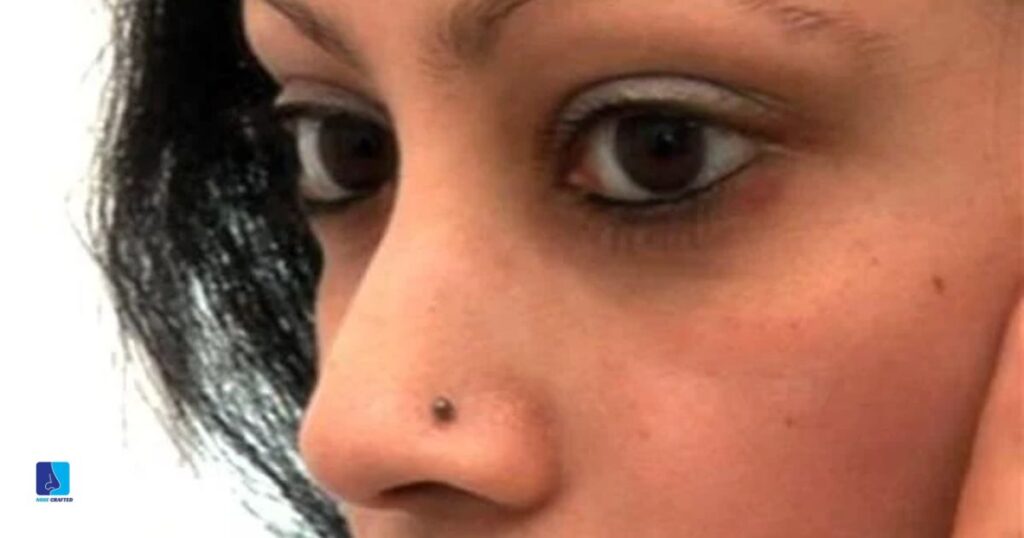
Getting an embedded nose ring out requires patience and care. First, ensure your hands are clean to prevent any infection. Gently push the skin around the embedded area away from the ring, using a clean cotton swab soaked in saline solution to soften the skin. If the ring remains embedded, consider seeking professional help from a piercer or a healthcare provider.
You can try soaking your nose in warm saline solution to help loosen the skin around the ring. Avoid forcefully pulling the ring out, as this can cause further irritation and damage. If the ring still doesn’t budge, it’s best to seek assistance to avoid complications.
Remember, attempting to remove an embedded nose ring can be risky if not done properly. Always prioritize your safety and seek professional guidance if you encounter difficulty.
Can You Save An Embedded Piercing?
When dealing with an embedded piercing, prompt action is key to potentially saving it. The first step is to assess the situation calmly. Determine if the piercing is truly embedded, meaning the jewelry has sunk into the skin, or if it’s simply irritated. If it’s embedded, resist the urge to remove the jewelry yourself as this could worsen the situation and lead to further complications.
Next, gently clean the area around the piercing with a saline solution or mild soap and warm water. Avoid using alcohol or hydrogen peroxide as they can be too harsh and further irritate the skin. After cleaning, apply a warm compress to the area to help reduce swelling and encourage circulation. This can sometimes help the jewelry to loosen naturally.
If the piercing remains embedded or continues to cause discomfort, it’s crucial to seek professional help from a piercer or healthcare provider. They can assess the situation and provide appropriate guidance or treatment. In some cases, the jewelry may need to be removed temporarily to allow the area to heal before reinserting it, while in other cases, more extensive measures may be necessary. Remember, early intervention is key to potentially saving the piercing and preventing further complications.
What To Do If Nose Stud Is Sinking?

Sure, here’s a simple table outlining steps to take if a nose stud is sinking:
| What to Do if Nose Stud is Sinking |
| Step 1: Assess the Situation |
| Determine if the stud is truly sinking into the skin or if it’s just irritated. |
| Step 2: Clean the Area |
| Gently clean the area around the piercing with a saline solution or mild soap and warm water. Avoid harsh substances like alcohol or hydrogen peroxide. |
| Step 3: Apply a Warm Compress |
| Apply a warm compress to the area to help reduce swelling and encourage circulation. This may help the jewelry to loosen naturally. |
| Step 4: Seek Professional Help |
| If the sinking persists or causes discomfort, seek assistance from a piercer or healthcare provider. They can assess the situation and provide appropriate guidance or treatment. |
| Step 5: Follow Professional Advice |
| Follow any advice or instructions provided by the professional to address the sinking stud effectively and prevent further complications. |
This table provides a clear and organized guide on what to do if a nose stud is sinking, ensuring proper care and management of the situation.
Why Is The Skin Around My Nose Piercing Hard
The hardness around a nose piercing can often be attributed to a build-up of scar tissue, known as hypertrophic scarring. This type of scarring occurs when the body’s natural healing process produces excess collagen around the piercing site, resulting in a firm or raised area of skin. It’s a common occurrence with nose piercings, especially if proper aftercare isn’t followed or if the piercing experiences trauma or irritation.
Additionally, the type of jewelry used in the piercing can contribute to the hardening of the skin. Jewelry made of materials such as stainless steel or titanium is generally recommended for new piercings due to their hypoallergenic properties and reduced risk of irritation. However, if low-quality or improper jewelry is used, it can lead to inflammation and the formation of scar tissue around the piercing site, causing the skin to become hard.
To address hardness around a nose piercing, it’s important to practice proper aftercare, including cleaning the area with saline solution and avoiding excessive touching or manipulation. If hypertrophic scarring occurs, gentle massaging with vitamin E oil or applying silicone gel sheets may help soften the skin over time. However, if the hardness persists or is accompanied by pain, redness, or discharge, it’s essential to seek advice from a professional piercer or healthcare provider to ensure proper treatment and prevent complications.
FAQ,s
How do you heal an embedded nose piercing?
To heal an embedded nose piercing, seek professional assistance from a piercer or healthcare provider for proper evaluation and treatment.
What to do if nose piercing is embedding?
If a nose piercing is embedding, seek professional advice from a piercer or healthcare provider for proper assessment and treatment.
How do you fix an embedded piercing?
To fix an embedded piercing, seek professional assistance for safe extraction and proper healing.
How do you remove an embedded nose stud?
To remove an embedded nose stud, soak the area in warm saline solution to soften the skin, then gently twist and wiggle the stud while pulling it out.
Conclusion
In conclusion, nose piercings are a popular form of self-expression and adornment that have been embraced by various cultures worldwide. While they can enhance one’s appearance and style, it’s crucial to prioritize proper aftercare to avoid complications such as hypertrophic scarring or embedded jewelry. Understanding the reasons behind skin hardening around nose piercings, such as hypertrophic scarring and irritation from low-quality jewelry, underscores the importance of attentive care and choosing high-quality materials for initial piercing and subsequent jewelry changes.
Furthermore, addressing issues like embedded nose studs requires patience and diligence. By following recommended techniques, such as soaking the area in warm saline solution and gently manipulating the jewelry, individuals can effectively manage discomfort and promote healing. Seeking guidance from professional piercers or healthcare providers when encountering challenges ensures that proper steps are taken to maintain the health and integrity of the piercing. Ultimately, with attentive care and timely intervention, individuals can enjoy their nose piercings as a stylish and meaningful form of self-expression while minimizing the risk of complications.
